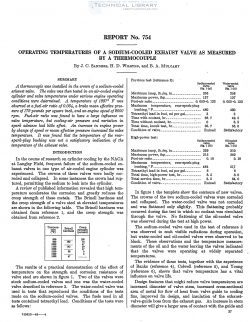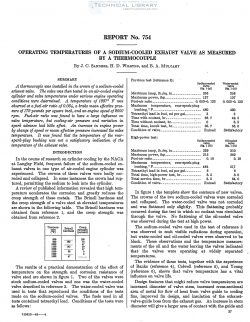naca-report-754

- Version
- 246 Downloads
- 916.19 KB File Size
- 1 File Count
- August 30, 2016 Create Date
- August 30, 2016 Last Updated
National Advisory Committee for Aeronautics, Report - Operating Temperatures of a Sodium Cooled Exhaust Valve as Measured by a Thermocouple

A thermocouple was installed in the crown of a sodium-cooled
exhaust valve. The valve was then tested in an air-cooled engine
cylinder and valve temperatures under various engine operating
conditions were determined. A temperature of 1337° F was
observed at a fuel-air ratio of 0.064, a brake mean efiective pres~
sure of 17.9 pounds per square inch, and an engine speed of 2000
rpm. Fuel-air ratio was found to have a large influence on
valve temperature, but cooling~air pressure and variation in
spark advance had little efl'ect. An increase in engine power
by change of speed or mean efiective pressure increased the valve
temperature. It was found that the temperature of the rear—
sparlc-plug bushing was not a satisfactory indication of the
temperature of the exhaust valve.
In the course of research on cylinder cooling by the NACA
at Langley Field, frequent failure of the sodium-cooled ex-
haust valves in one type of air—cooled engine cylinder was
experienced. The crowns of these valves were badly cor—
roded and collapsed. In some instances the crown had rup—
tured, permitting the sodium to leak into the cylinder.
A review of published information revealed that high tem-
perature accelerates the corrosion and greatly reduces the
creep strength of these metals. The Brinell hardness and
the creep strength of a valve steel at elevated temperatures
are shown in the following table. The Brinell hardness was
obtained from reference 1, and the creep strength was
obtained from reference 2.
The results of a practical demonstration of the effect of
temperature on the strength and corrosion resistance of
valve steel are shown in figure 1. _Two of the valves were
stock sodium-cooled valves and one was the water—cooled
valve described in reference 3. The water-cooled valve was
used in tests that reproduced the conditions of the tests
made on the sodium-cooled valves. The fuels used in all
tests contained tetraethyl lead.
| File | Action |
|---|---|
| naca-report-754 Operating Temperatures of a Sodium Cooled Exhaust Valve as Measured by a Thermocouple.pdf | Download |
Comment On This Post